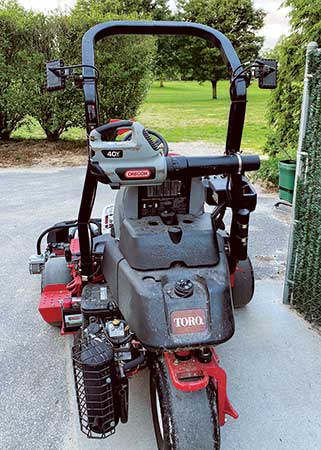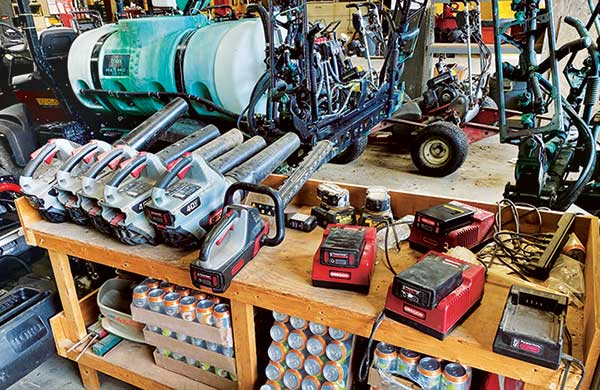Battery Power: Unheard heroes

These greens mowers tackle North Hempstead CC’s 22 greens with handheld blowers and backup batteries. (Photo: Tom Kaplun)
Many consider the golf maintenance team the unsung heroes of the golf operation, but some superintendents would trade that moniker for the unseen and even unheard heroes of the golf operation.
Tom Kaplun, superintendent at North Hempstead Country Club in Port Washington, N.Y., falls into this camp. With two sides of the club’s property line adjoining residential areas and the concern of disturbing members at the clubhouse, Kaplun was intrigued when he met with the team at Oregon Products at the 2014 Golfdom Summit.
After seeing the company’s blowers and trimmers in action, he decided to give them a shot.
Today, Kaplun has an entire arsenal of battery-powered equipment for him and his crew at North Hempstead, with an eye on expansion. Blowers and trimmers are his favorites, and he’s also added an electric Cushman Hauler for his own transportation, and an electric Cushman with a Refresher Drop-In is now the beverage cart.
“(My interest) was twofold: It was working around the clubhouse or the practice putting green … and the neighbors complaining about the early-morning disturbance,” Kaplun recalls. “Now, I have eight of the cordless blowers with rapid chargers and two hedge trimmers. The hedge trimmers can go all day. We have quite a few ornamental plantings around the clubhouse. The complaint was the right time to do it without interrupting the members. The battery-powered hedge trimmers are so quiet, we can do it any time of day now, and it’s a nonissue.”
Two batteries, 22 greens
Kaplun reports that the blowers pack the same power as a gas blower, but they won’t last as long. His crew can get about 20 minutes out of a single charge on the low side, and that’s if they have the throttle locked at full blast for the full 20.
In order to make the blowers last for 22 greens, Kaplun got creative. For triplex greens mowers and the greens rollers, he’s attached a blower holder to the rollover protection structure on both machines. Each operator has a second battery on a rapid charger with him, so he can switch out batteries when one dies out.
“The thing I like about them is I don’t have to worry about any gas or oil spills, along with the noise reduction,” Kaplun says. “Two batteries will last through all 22 greens we cut, blowing off small debris. Now, if we have a heavy storm, obviously it’s a different situation; I’ll get more manpower out there, and we’ll get some gas blowers. But, I’m trying to eliminate the gas blowers as much as possible from blowing greens.”
Jason Wilk, product manager for Echo, echoes (ahem) those comments.

Tom Kaplun’s crew at North Hempstead CC tries to use only battery-powered blowers when blowing off greens. (Photo: Tom Kaplun)
“The questions we get from superintendents mainly revolve around their need to understand if the battery blower will contain enough performance — and the run time of cordless compared to gas blowers can be a concern,” Wilk says. “Most manufacturers offer larger-capacity batteries that can provide continuous run times up to a half an hour or more. Having multiple batteries will enable you to work all day, nonstop.”
Wilk says that electric motor technology (brushless motors) and battery technology (lithium ion) have grown exponentially over the last several years. Battery-powered blowers can produce as much air volume and air speed as small gas-powered handheld blowers, he says, and Kaplun agrees.
“It doesn’t last as long as the gas-powered blower but is much quieter, and I do find the power to be just as good as a gas blower,” Kaplun says.
Like a new car
Kaplun is looking into adding battery-powered string trimmers eventually. And, his electric Cushman is a huge advantage for him in terms of how quickly he can get around the course.
“I don’t have to wait for groups when they’re hitting shots or on the greens,” he says. “I just get around the course so much quicker with less disturbance than on a gas cart. One charge gets me almost two days.”
The only battery-powered equipment he’s not comfortable with yet is mowers.
“I have not found any kind of battery-powered mowers that can handle the hills we have,” Kaplun says. “And, I haven’t gotten complaints about mowers like I have with blowers and those other things.”
The team at Kansas State University in Manhattan, Kan., has employed an electric greens mower for the last five years, and results are positive, with a few caveats.
“It’s awesome for us. I have nothing but great things to say about it,” says Dani McFadden, graduate research assistant, Kansas State University. “It’s like a new car that shuts off when you brake for too long. Sometimes, I have to look down to make sure it’s on, that it’s cutting, to see that I’m getting clippings.”
McFadden also appreciates that the reels can be sped up on the mower, even when going slow, so a single cut is like a double cut. But then there’s the “but.”
“But, if you get it out to Colbert Hills (Golf Course, Manhattan, Kan.), they might not think it’s as great,” she says. “They have hills and 18 greens to mow. We only have 17,000 square feet of research greens, and it’s completely flat. But it’s great for us and the way we use it.”
Night and day
Battery-powered equipment in golf is not exactly new, says Emil Miller, marketing manager, Smithco. He has the experience, and the horror stories, to prove it.
His company has two new battery-powered offerings, a new bunker rake and a new greens roller. How new? New enough that they only introduced the bunker rake at the New England Turfgrass Show in March, back when trade shows were a thing. The greens roller is still in the research and development stage, but set to debut soon.
“We built our first electric-powered bunker rake in 1992,” Miller says. “We built it with golf cart technology, and it was a huge failure — we’ll be the first to admit. We upgraded it through the years. In the late ’90s, we switched to some industrial technology that worked well but lost our vendor. Now we got back into it 18 months ago, and we’re seeing acceptance because everybody is going green.”
Miller says the battery-powered market is “night and day” when it comes to acceptance among superintendents from back in the early ’90s and 2000s to today. The reasons, he says, are because people are more environmentally minded and because the technology has improved so much over the years.
“Look at what’s going on in the rest of the world, in terms of vehicles, power tools and everything else,” he says. “E-Z-Go makes a golf car now that runs for days. It’s the same technology we put on the bunker rakes. It’s just a change in paradigm.”
Miller says the main draw of the battery-powered bunker rake is the same thing Kaplun and McFadden enjoy about their battery-powered equipment: the silence. On a typical golf maintenance day, the mowers go out first, Miller says. Once they’re done, the bunker rakes go out second — but now they have golfers to contend with.
“They have to wait (on golfers). Now, we have a machine that makes no noise,” Miller says. “Instead of waiting for play, they can literally rake bunkers as long as they are out of sight, out of play, with no disturbance to the tee sheets.”
Miller also has high hopes for the company’s electric greens roller. He says in the ’90s and 2000s, a similar product used to do well for them as loaners — to major tournaments like the Ryder Cup — for the week of the event. “For some reason, superintendents wanted them on-site for major tournaments,” he says with a laugh, “but never trusted them the rest of the year.”
Lithium batteries in the greens rollers will be a game-changer, Miller says, because now the rollers will be the same weight as traditional rollers, minus the noise and the risk of leaks. He thinks all the advancements will have the attention of superintendents soon.
Now, there’s just someone else they need to convince.
“Our biggest hurdle is the equipment technician,” Miller says, “because they love their combustion engines. Batteries don’t last forever, but gas engines don’t last forever. Nothing lasts forever … well, lies last forever.”
Truth.











